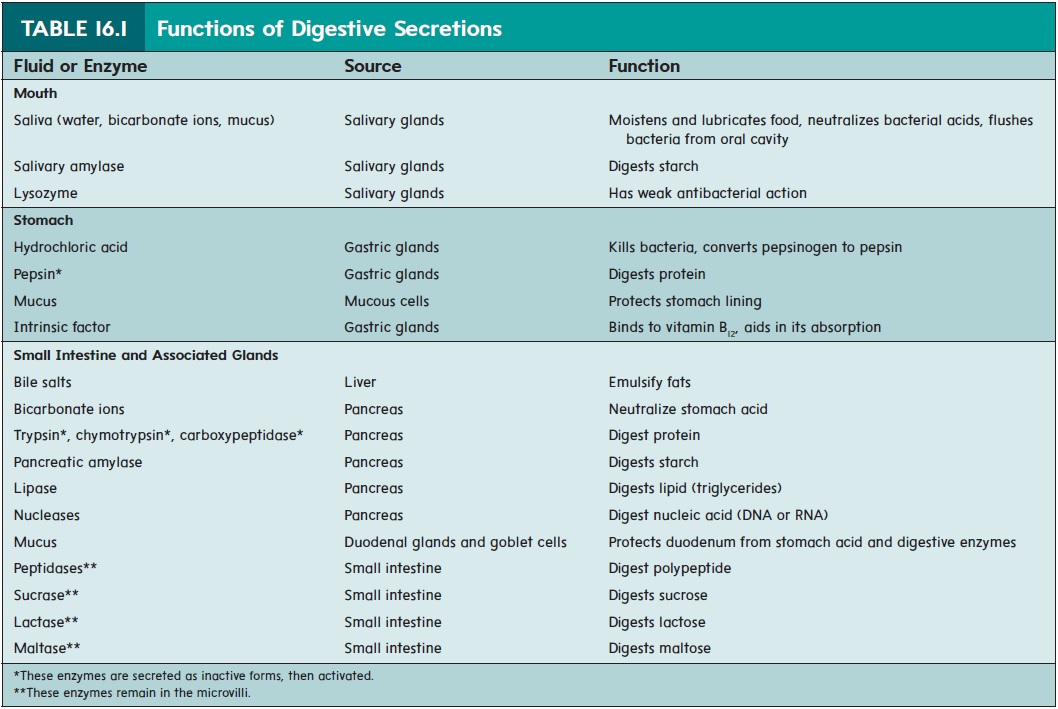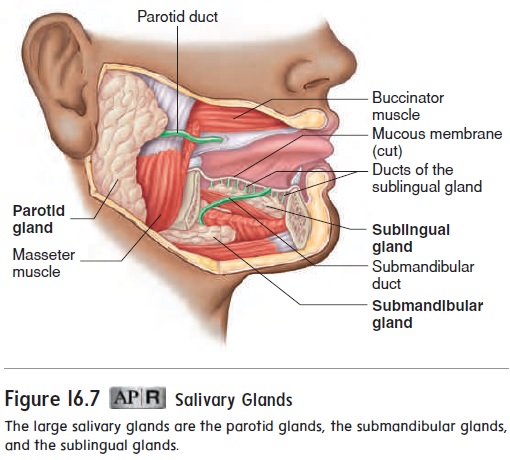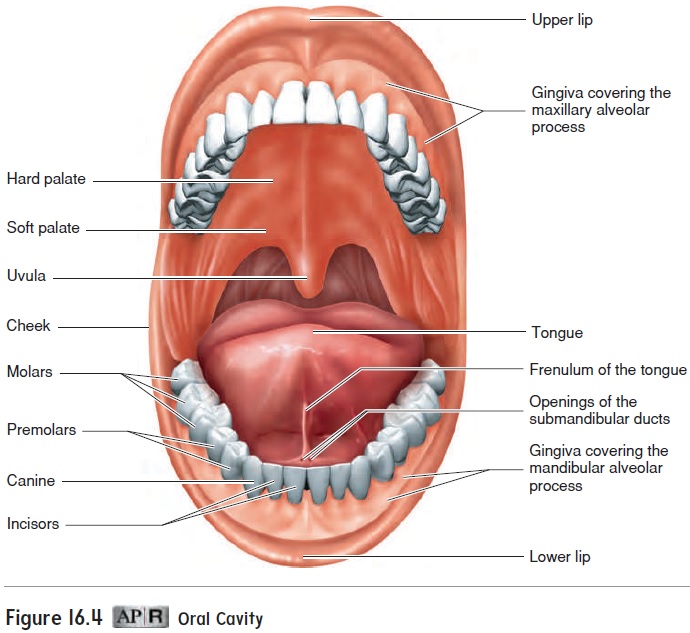Chapter: Essentials of Anatomy and Physiology: Digestive System
Saliva
Saliva
Saliva (să-lı̄′ vă) helps keep the oral cavity moist and containsenzymes that begin the process of digestion. Saliva is secreted at the rate of approximately 1 liter (L) per day. The serous part of saliva, produced mainly by the parotid and submandibular glands, contains a digestive enzyme called salivary amylase (am′ il-ās) (table 16.1), which breaks the covalent bonds between glucose molecules in starch and other polysaccharides to produce the disaccharides maltose and isomaltose. Maltose and isomaltose have a sweet taste; thus, the digestion of polysaccharides by salivary amylase enhances the sweet taste of food.
Food spends very little time in the mouth. Consequently, only about 5% of the total carbohydrates humans absorb are digested in the mouth. Also, most starches are contained in plant cells, which are surrounded by cell walls composed primarily of the polysaccharide cellulose (sel′ ū-lōs). Humans lack the necessary enzymes to digestcellulose. Cooking and thorough chewing of food disrupt the cel-lulose covering and increase the efficiency of the digestive process.

In addition to its role in digestion, saliva protects the mouth from bacterial infection by washing the oral cavity with lysozyme (lı̄′ sō-zı̄m), a mildly antibacterial enzyme. Saliva also neutralizes the pH in the mouth, which reduces the harmful effects of bacterial acids on tooth enamel. Lack of salivary gland secretion (which can result from radiation therapy) increases the chance of ulceration and infection of the oral mucosa and caries (cavities) formation in the teeth.
The serous part of saliva dissolves molecules, which must be in solution to stimulate taste receptors. The mucous secretions of the submandibular and sublingual glands contain a large amount of mucin (mū′ sin), a proteoglycan that gives a lubricating quality to the secretions of the salivary glands.
Salivary gland secretion is regulated primarily by the auto-nomic nervous system, with parasympathetic stimulation being the most important. Salivary secretions increase in response to a variety of stimuli, such as tactile stimulation in the oral cav-ity and certain tastes, especially sour. Higher brain centers can stimulate parasympathetic activity and thus increase the activity of the salivary glands in response to the thought of food, to odors, or to the sensation of hunger. Sympathetic stimulation increases the mucous content of saliva. When a person becomes frightened and the sympathetic division of the autonomic nervous system is stimulated, the person may have a dry mouth with thick mucus.
Salivary Glands
There are three major pairs of salivary (sal′ i-vār-ē) glands: the parotid, submandibular, and sublingual glands (figure 16.7). A con-siderable number of other salivary glands are scattered throughout the oral cavity, including on the tongue. Salivary glands produce saliva, which is a mixture of serous (watery) and mucous fluids. The salivary glands are compound alveolar glands. They have branching ducts with clusters of alveoli, resembling grapes, at the ends of the ducts .

The largest of the salivary glands, the parotid (pă-rot′ id; beside the ear) glands, are serous glands located just anterior to each ear. Parotid ducts enter the oral cavity adjacent to the second upper molars.
Mumps (mŭmpz) is an inflammation of the parotid glandcaused by a viral infection. The inflamed parotid glands become swollen, often making the cheeks quite large. The virus causing mumps can also infect other structures. Mumps in an adult male may involve the testes and can result in sterility.
The submandibular (sŭb-man-dib′ ū-lăr; below the mandible) glands produce more serous than mucous secretions. Each glandcan be felt as a soft lump along the inferior border of the mandible. The submandibular ducts open into the oral cavity on each side of the frenulum of the tongue (see figure 16.4).

The sublingual (sŭb-ling′ gwăl; below the tongue) glands, the smallest of the three paired salivary glands, produce primarily mucous secretions. They lie immediately below the mucous mem-brane in the floor of the oral cavity. Each sublingual gland has 10–12 small ducts opening onto the floor of the oral cavity.
The sublingual (sŭb-ling′ gwăl; below the tongue) glands, the smallest of the three paired salivary glands, produce primarily mucous secretions. They lie immediately below the mucous mem-brane in the floor of the oral cavity. Each sublingual gland has 10–12 small ducts opening onto the floor of the oral cavity.
Related Topics